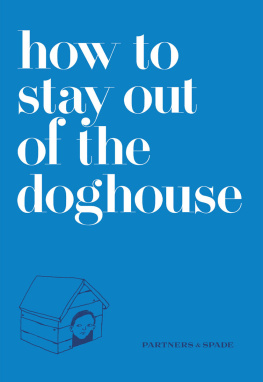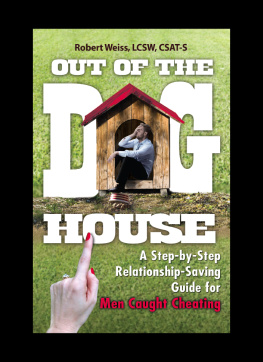Twitchell - Building a Doghouse
Here you can read online Twitchell - Building a Doghouse full text of the book (entire story) in english for free. Download pdf and epub, get meaning, cover and reviews about this ebook. year: 2000;2001, publisher: Storey Publishing, LLC, genre: Home and family. Description of the work, (preface) as well as reviews are available. Best literature library LitArk.com created for fans of good reading and offers a wide selection of genres:
Romance novel
Science fiction
Adventure
Detective
Science
History
Home and family
Prose
Art
Politics
Computer
Non-fiction
Religion
Business
Children
Humor
Choose a favorite category and find really read worthwhile books. Enjoy immersion in the world of imagination, feel the emotions of the characters or learn something new for yourself, make an fascinating discovery.

- Book:Building a Doghouse
- Author:
- Publisher:Storey Publishing, LLC
- Genre:
- Year:2000;2001
- Rating:5 / 5
- Favourites:Add to favourites
- Your mark:
- 100
- 1
- 2
- 3
- 4
- 5
Building a Doghouse: summary, description and annotation
We offer to read an annotation, description, summary or preface (depends on what the author of the book "Building a Doghouse" wrote himself). If you haven't found the necessary information about the book — write in the comments, we will try to find it.
Building a Doghouse — read online for free the complete book (whole text) full work
Below is the text of the book, divided by pages. System saving the place of the last page read, allows you to conveniently read the book "Building a Doghouse" online for free, without having to search again every time where you left off. Put a bookmark, and you can go to the page where you finished reading at any time.
Font size:
Interval:
Bookmark:
Mary Twitchell

Dogs and owners live by an unspoken pact: Dogs provide an owner with affection and companionship; in return, a dogs master is responsible for providing food, shelter, veterinary care, and loving attention. A doghouse is one of the tools by which owners can live up to their end of the bargain.
Dogs are social animals; to thrive both emotionally and physically, they need human interaction. Doghouses, therefore, are not meant to serve as permanent living spaces. Dogs belong with their owner and their owners family. Dogs are best housed indoors or in spaces with access to areas of family activity. Doghouses serve merely as shelters within a fenced-in area for canines that have been put outside temporarily.
There are many reasons why an owner might put the dog outside. Some dogs, when left indoors alone during the day, seemingly cannot resist destroying the house. Some dogs smell unpleasant periodically or shed copiously at certain times of the year. Partially house-trained animals are perhaps best left outside when you are away; repeated accidents on the living room rug can quickly try your patience.
And dogs do misbehave. They often become overenthusiastically friendly usually when visitors or neighborhood children appear. Many is the horrified guest who has been lovingly greeted by the leap of a Siberian husky or golden retriever. And small children can be flattened by the love and licks of a cocker spaniel. To invite friends and their dogs to a barbecue is always a disaster; the event quickly dissolves into a cacophony of owners yelling and dogs barking as food is surreptitiously removed from unguarded paper plates. At such critical moments, when you must enforce order, a nearby fenced-in area with a shelter provides your dog with his own protected space and you with peace of mind.
Dogs like and need time out. By giving your dog a doghouse, you provide the space for that quiet time, and with a little training (see page 31), your dog will use his house willingly.
Sometimes providing a private shelter for your dog is as simple as adapting your house or garage. If you live in a temperate climate, dogs can find shelter from adverse weather in the garage or other outbuilding or beneath a deck. Such adaptations are usually the easiest and cheapest solution, but theyre not always ideal. Because dogs depend on their body heat to keep warm, garages and sheds are sometimes too cold, large, wet, and drafty in winter and too poorly ventilated in summer.
For owners who do not have an easy garage-and-yard or other setup, or for owners who want to provide housing that better matches their dogs needs, there are a number of doghouse options to choose from. These include crates, barrels, high-impact plastic houses, and wooden doghouses.
Just as we have become dependent on dogs, so too have they become dependent on us. No dog, not even the northern breeds with thick coats (St. Bernards, sheepdogs, and huskies), should be left outside once temperatures plummet into the teens or single digits. The animal may suffer frostbite of ears, paws, or scrotum, or he may develop hypothermia. Both conditions are potentially dangerous. Nor should a dog be moved back and forth from hot to cold. Such sudden and dramatic shifts in temperature can cause severe, even fatal, illness.
Although doghouses are designed to conserve the animals body heat, they are not meant to shelter an animal from extreme cold or hot temperatures. Therefore, think of building a doghouse to protect your animal from wind, rain, and snow, but not from severe cold or intense heat. If you must put your dog outside during periods when extreme weather is possible, be sure that the animal has access to the moderated temperatures of your home, be it the basement, laundry room, bathroom, kitchen, or utility room.
Cold-Climate Warning
There are people who cite dogs living in the far North (huskies, usually) that reside outdoors all year. They point out that even in temperatures of -30 degrees and 30 knot winds, the huskies burrow into the snow, where they remain warm overnight. Although this is certainly true, there have been tragic mistakes when, out of misguided kindness, people have brought these dogs inside to warm up, then returned them to the frigid outdoors. The tragedy begins as inside temperatures melt the snow matted to the dogs hair. When the dog is put back outside, this snow, now water, freezes, causing the animal to cool off, then freeze to death.
Most important, remember that a doghouse is a vacation retreat, a room of ones own, a space for personal time; it is not a full-time, year-round shelter.
Dog owners with outdoor kennels in open, spacious yards may be tempted to chain their animals. Dont. It makes little difference to what the dog is chained, be it a tree or her doghouse; the animal may get the chain entangled. If the day is hot and the chain is wrapped around a tree, the dog cant reach her water bowl and may quickly become dehydrated. Dogs have also choked to death when chained: Another dog (or rabbit or other animal) passes by, the dog gets excited, tries to jump the fence, doesnt have enough leash, and hangs herself. Even if no tragedy results, dogs suffer in close confinement. Therefore never chain an animal except for very brief times and only when someone is around. Chained dogs are also more likely to become vicious, more likely to bite and bark, and will certainly turn their restricted space into a muddy mess.
Dog owners who leave their dogs outside for any length of time should never allow the dog to run free. On the other hand, chaining a dog is excessively confining; dogs by nature want to be active. The best solution is a fenced-in yard, but that can be expensive. The next best solution is to build (or buy) a dog pen or kennel run. Fenced areas give your dog greater parameters but keep her out of trouble.
Doghouses are perfect complements to fenced-in yards and kennel runs. The open space allows the dog freedom of movement, and the doghouse provides shelter from the elements and a space to retreat from the outside world.
Kennel runs should be located where they are protected from hot or cold winds; they should be large enough to provide the dog with sufficient space in which to get exercise. A chain-link pen 6 feet by 10 feet by 6 feet high might be appropriate. Longer, more narrow, rectangular areas can cause a dog to run the fence, pacing back and forth along the fence line. Kennel runs with grass as the flooring material will quickly become dirt, and the dirt will quickly become mud. Therefore, choose a concrete or gravel flooring.
Confine a dog to a pen for only a few hours at a time. Remember, kennels and dog pens are never replacements for a run with you in the woods or life with you in the big house.
Some people own open mesh, solid metal or plastic crates for transporting their animal. These crates are light, versatile, and easy to use. Many owners also use the crates for house-training their pets, as indoor doghouses, as whelping boxes if they are breeding dogs, or for enclosures if they need their animal temporarily restrained or disciplined. Once you own a metal crate, it is logical to think of adapting it for use as an outdoor kennel especially since crates are expensive. You can improve the comfort of a crate-as-kennel by adding floor bedding. However, crates are extremely drafty. Rain, snow, wind, and sudden changes in temperature are immediate problems. Throwing plastic over the crate will protect your animal somewhat, but it isnt a long-term solution. Although you can make do with a crate as a doghouse when you need to, I recommend that you consider a more weatherproof option, such as a modified barrel or a plastic or wooden doghouse.
Font size:
Interval:
Bookmark:
Similar books «Building a Doghouse»
Look at similar books to Building a Doghouse. We have selected literature similar in name and meaning in the hope of providing readers with more options to find new, interesting, not yet read works.
Discussion, reviews of the book Building a Doghouse and just readers' own opinions. Leave your comments, write what you think about the work, its meaning or the main characters. Specify what exactly you liked and what you didn't like, and why you think so.




